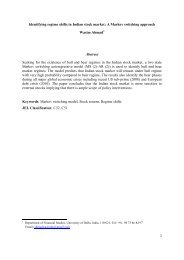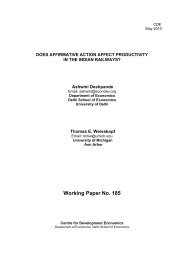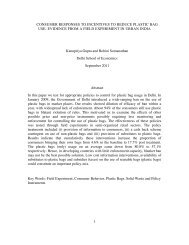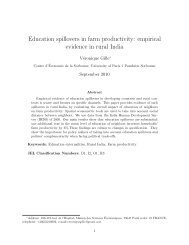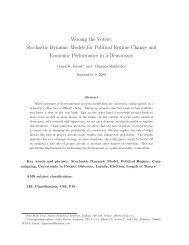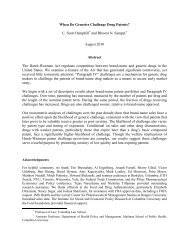Dismantling the Legacy of Caste - Centre For Development Economics
Dismantling the Legacy of Caste - Centre For Development Economics
Dismantling the Legacy of Caste - Centre For Development Economics
You also want an ePaper? Increase the reach of your titles
YUMPU automatically turns print PDFs into web optimized ePapers that Google loves.
ottom panel <strong>of</strong> Figure 2. By contrast, as shown in <strong>the</strong> bottom panel <strong>of</strong> Figure 2, <strong>the</strong> entry examination<br />
scores exhibit a great deal <strong>of</strong> variation at <strong>the</strong> upper end <strong>of</strong> <strong>the</strong> distribution. Thus, <strong>the</strong> entry examination<br />
provides more differentiation among high ability students than does <strong>the</strong> high school examination. As we<br />
demonstrate in <strong>the</strong> empirical analysis that follows, this is captured quite well by our latent ability measure<br />
in equation (2) for explaining performance in engineering colleges. <strong>For</strong> more prestigious institutions,<br />
however, <strong>the</strong> entry examination score provides an additional source <strong>of</strong> information for differentiating<br />
among applicants. Our empirical analysis shows this to be quite important in <strong>the</strong> attendance equation.<br />
Let I y be a latent index <strong>of</strong> propensity to attend an engineering college. We choose a flexible<br />
specification with caste fixed effects and high-order polynomials in r,<br />
, and s. As detailed in <strong>the</strong><br />
empirical section, a specification with a fourth-order polynomial in r and third-order polynomials in<br />
and s fits matriculation decisions quite well and yields findings that conform with <strong>the</strong> predictions<br />
developed in <strong>the</strong> derivation <strong>of</strong> equation (9):<br />
(12)<br />
4 3 3<br />
r k k s k<br />
y<br />
<br />
ij 0<br />
<br />
j<br />
k ij<br />
k ij<br />
k ij<br />
<br />
ij<br />
k 1 k 1 k 1<br />
for j=O, ST, SC, BC-A, BC-B, BC-C, BC-D.<br />
I r s u<br />
The open category is <strong>the</strong> reference category.<br />
As we explained in connection with <strong>the</strong> achievement model, we have relatively strong priors<br />
about <strong>the</strong> relative magnitudes <strong>of</strong> <strong>the</strong> coefficients comprising latent aptitude,<br />
, in <strong>the</strong> achievement<br />
equation. <strong>For</strong> <strong>the</strong> attendance equation, <strong>the</strong> polynomials in<br />
and s provide a flexible specification for<br />
capturing trade<strong>of</strong>fs that prospective students make among no-college, engineering college, and o<strong>the</strong>r<br />
higher education options. Aside from <strong>the</strong> expectation <strong>of</strong> an inverted-U relationship <strong>of</strong> aptitude and<br />
attendance, we do not have predictions about <strong>the</strong> relative magnitudes <strong>of</strong> <strong>the</strong> coefficients comprising in<br />
and s in <strong>the</strong> attendance equation.<br />
4.3. Selection<br />
In derivation <strong>of</strong> our achievement equation (4), we argued that <strong>the</strong> coefficient <strong>of</strong> effective rank, r ,<br />
and <strong>the</strong> caste fixed effects, j , are not biased in <strong>the</strong> presence <strong>of</strong> unmeasured ability. Hence, from <strong>the</strong><br />
21



